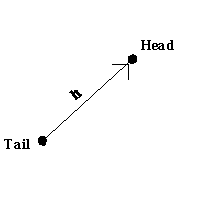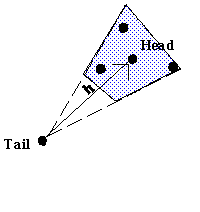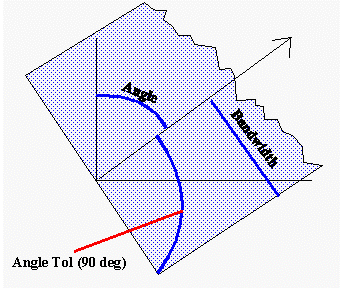SADA characterizes spatial correlation through the use of the semi-variogram model, which provides a measure of variance as a function of distance between data points. This measure is defined as half of the average squared difference between two values separated by vector h: (Deutsch and Journel, GSLIB Geostatistical Software Library and User’s Guide, 1992)
![]()
where N(h) is the number of pairs separated by vector h, xi is the starting point (tail), and yi is the ending point (head).

In practice, the number of points separated exactly by vector h will be very small or none at all. Therefore, a distance and direction tolerance is allowed to capture more data points in the calculation of ((h). In the figure below, all data points within the blue shaded area will be used.

The distance component of h is referred to as the lag. The tolerance associated with the lag is called the lag tolerance. In practice, for a specified direction, the semivariogram may be calculated for a number of lags. The tolerance associated with a direction is referred to as the angle tolerance. These components together form a cone which can be constrained by the bandwidth factor. The bandwidth controls the maximum width across the cone and allows the cone to focus more on the specified direction.
A check for isotropic correlation is possible using the Omnidirectional variogram. The corresponding cone for this variogram allows the data in all directions to be used in calculation. The omni directional variogram is available by setting the Tol (Ztol) equal to 90 degrees during the Correlation Modeling step. Under the omni directional case, the bandwidth and angle parameters can still have an effect on results. Setting the angle equal to 45 degrees and the bandwidth equal to 100 feet, with an angle tolerance of 90 degrees produces the following cone.

In order to include every point, the bandwidth must be made large enough to encompass all datapoints.
Experimental variography provides estimated values of the correlation structure for a finite number of distances. When performing ordinary kriging or indicator kriging, semivariogram values for any distance may be required. Therefore, a model must be fit to the semivariogram values to provide a semivariogram value for any distance.
Explanation of valid semivariogram models and how to use them are beyond the scope of this manual. It is assumed that the user is familiar with fitting correlation models. For a detailed explanation of these models see GSLIB Geostatistical Software Library and User’s Guide by Deutsch and Journel (1992).
SADA provides three standard models for this purpose: Spherical, Exponential, and Gaussian. In addition to these three models, a nugget effect is also available. Furthermore, SADA allows two nested correlation structures.
See the Model spatial correlation interview or correlation modeling step.